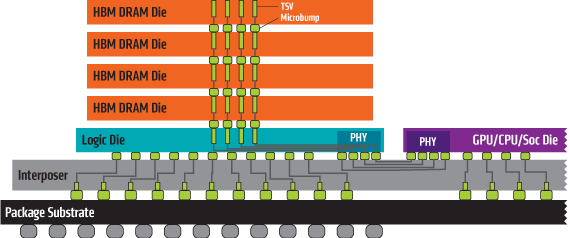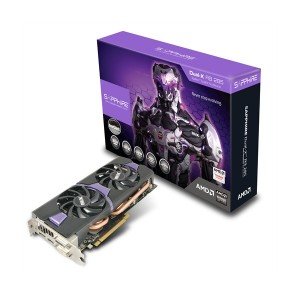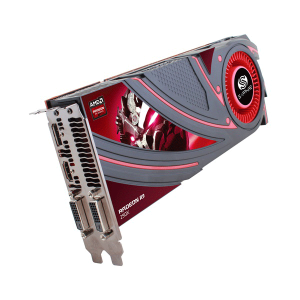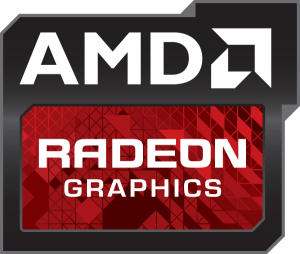 In order for a graphics processor to produce high quality images in 3D, it has to deal with a huge amount of data. As the screen resolutions and details increased, the graphics processor have had to get faster and more efficient. One of the big bottlenecks for this process is the memory. The amount of memory required has also increased. Not only that, but the speed at which that data needs to move from video memory to the graphics processor also has to improve. The primary video graphics memory has been GDDR5. The problem is that this is now reaching its limits in terms of both power and speed. AMD and the JDEC have come up with a new solution they are calling HBM (High Bandwidth Memory). Find out how this could help improve your future PC graphics for both desktop and laptop systems. Continue reading
In order for a graphics processor to produce high quality images in 3D, it has to deal with a huge amount of data. As the screen resolutions and details increased, the graphics processor have had to get faster and more efficient. One of the big bottlenecks for this process is the memory. The amount of memory required has also increased. Not only that, but the speed at which that data needs to move from video memory to the graphics processor also has to improve. The primary video graphics memory has been GDDR5. The problem is that this is now reaching its limits in terms of both power and speed. AMD and the JDEC have come up with a new solution they are calling HBM (High Bandwidth Memory). Find out how this could help improve your future PC graphics for both desktop and laptop systems. Continue reading
AMD’s New Radeon R9 285 Card Does More With Less
 Let’s face it, most people who are getting a graphics card on their system are doing so to play games but they don’t need a huge amount of performance because they only have a 1920×1080 resolution display. Because of this, the majority of the graphics card sold on the market cost less than $300. AMD just released their latest graphics card, the Radeon R9 285, priced around $250 as a mainstream option for those that want a solid performance 3D graphics card. The weird thing is that if you look at the specs for the device, it looks to have less than the Radeon R9 280 that it is replacing. Can this card actually perform better with less? Continue reading
Let’s face it, most people who are getting a graphics card on their system are doing so to play games but they don’t need a huge amount of performance because they only have a 1920×1080 resolution display. Because of this, the majority of the graphics card sold on the market cost less than $300. AMD just released their latest graphics card, the Radeon R9 285, priced around $250 as a mainstream option for those that want a solid performance 3D graphics card. The weird thing is that if you look at the specs for the device, it looks to have less than the Radeon R9 280 that it is replacing. Can this card actually perform better with less? Continue reading
AMD Mantle: Empowering Gamers With Lesser Hardware
 Many people are probably not familiar with the early years of 3D gaming on the PC. There were a large number of companies producing graphics processor that dealt with the 3D geometry differently. In order for the hardware to work, the game had to be written specifically for that graphics card. This meant that sometimes you encountered games that might not run properly on your chosen graphics card. 3DFX was one company that succeeded well during this time because of their standardized Voodoo API and strong developer support.
Many people are probably not familiar with the early years of 3D gaming on the PC. There were a large number of companies producing graphics processor that dealt with the 3D geometry differently. In order for the hardware to work, the game had to be written specifically for that graphics card. This meant that sometimes you encountered games that might not run properly on your chosen graphics card. 3DFX was one company that succeeded well during this time because of their standardized Voodoo API and strong developer support.
Eventually, Microsoft standardized the software side of the games with Direct X that allowed a common programming API that could then be translated to the various hardware of the graphics cards. The eventually success of the API lead to the consolidation down to the two graphics card companies that we have today, AMD and NVIDIA. Over time, the Direct X API evolved but so has the complexity such that graphics performance gains are not as dramatic between generations of graphics cards. Now AMD is looking to go back to a more simplistic direct API system that would supposedly improve the performance of games with its graphics cards. Is this going to be the future of PC gaming? Continue reading
AMD Radeon R9 290X Offers Faster Gaming For Less Than NVIDIA
 The majority of AMD’s most recent graphics cards are not much more than renamed versions of existing cards. Frankly, there are not many benefits to buying the new R7 or R9 cards over the past generation. This changed with the announcement of the Radeon R9 290X late last week. This card differs from the others in that it really does offer a new experience for those looking at fast frame rates at high resolutions and aren’t looking to spend up to a $1000 for an NVIDIA GeForce TITAN card. In fact, retail prices are expected to be just $550 making it less expensive than even the GeForce GTX 780. Continue reading
The majority of AMD’s most recent graphics cards are not much more than renamed versions of existing cards. Frankly, there are not many benefits to buying the new R7 or R9 cards over the past generation. This changed with the announcement of the Radeon R9 290X late last week. This card differs from the others in that it really does offer a new experience for those looking at fast frame rates at high resolutions and aren’t looking to spend up to a $1000 for an NVIDIA GeForce TITAN card. In fact, retail prices are expected to be just $550 making it less expensive than even the GeForce GTX 780. Continue reading
AMD’s Radeon R9 and R7 VIdeo Cards Are Not That New
 AMD’s Radeon 7000 series graphics cards are some of the longest on the market ever. The first cards were originally released all the way back in late 2011. Since their initial release, the company has tweaked the clocks and released new models such as the GHz Editions but there really wasn’t much change. Now the company is introducing its latest graphics card lineup with the Radeon R9 and Radeon R7 series. While the names may be different, it seems that AMD is really just reworking the names more than their graphics card, something that NVIDIA has done repeatedly including the majority of the 700 series which are essentially rebadged 600 series cards. Let’s take a closer look at the changes AMD is making. Continue reading
AMD’s Radeon 7000 series graphics cards are some of the longest on the market ever. The first cards were originally released all the way back in late 2011. Since their initial release, the company has tweaked the clocks and released new models such as the GHz Editions but there really wasn’t much change. Now the company is introducing its latest graphics card lineup with the Radeon R9 and Radeon R7 series. While the names may be different, it seems that AMD is really just reworking the names more than their graphics card, something that NVIDIA has done repeatedly including the majority of the 700 series which are essentially rebadged 600 series cards. Let’s take a closer look at the changes AMD is making. Continue reading
